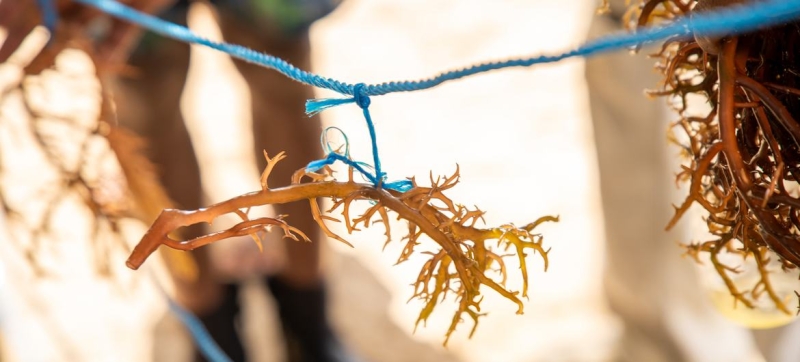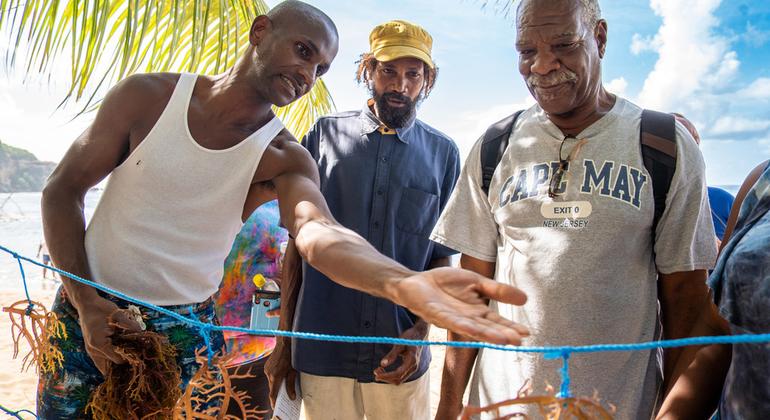
The fast-growing, self-cleaning species of sea moss Eucheuma cottonii provides the quantity and quality of product required for profitable commercial production. The transition to growing a new type of algae boosts the economy of Dominica Economic Development
Dominica, a small island nation in the eastern Caribbean, traditionally grows wild sea moss, a red algae of the species Gracilaria, from which drinks, gels and other products, such as textile dyes, are made. Read about how this fishery, despite many difficulties, is developing these days in the material of our colleagues from the Food and Agriculture Organization of the United Nations (FAO).
Like other types of sea moss, gracilaria is widely used in the food and cosmetics industry. However, its slow growth makes production and supply difficult, forcing farmers to import other varieties from neighboring islands to meet local demand.
Growing sea moss is a complex process: the algae is harvested, cleaned of weeds and debris, the collected plants are bleached and dried in the sun, and then the dried raw materials are packaged and sold.
It should be noted that a large number of weeds, such as epiphytes, settle on gracilaria. If other types of algae have the ability to self-clean, then cleaning gracilaria is a tedious and time-consuming job. Quite low product yield – on average 1 kg of dry material per 18 kg of raw material – reduces production profitability.
“Previously, many farmers grew gracilaria themselves. They encountered many difficulties in breeding it and did not always receive enough income. Some farmers lost motivation and gave up growing the crop,” says Dorian Sanford, state fisheries specialist in charge of aquaculture and mariculture.

And yet many continued to grow sea moss, despite the difficulties.
The transition to Eucheuma cottonii~ helped solve the problem 60~/em>is a commercial type of sea moss that has been grown in the region for many decades. It was proposed to be used as part of a Food and Agriculture Organization of the United Nations (FAO) project aimed at strengthening livelihoods, promoting sustainable development and creating sustainable agri-food value chains.
On the basis of the project, theoretical and practical classes were organized on growing Eucheuma cottonnii and rational methods of aquaculture farming. The sessions, led by Thomas Nelson, a sea moss expert from St. Lucia, included technicians, extension workers and farmers from three sea moss cooperatives.
A fast-growing, self-cleaning species of sea moss Eucheuma cottonii allows us to obtain the quantity and quality of products necessary for profitable production. The same work has been successfully done in St. Lucia and other neighboring islands, where sea moss is grown as a cash crop.
Since three large farming groups in the Woodford communities Hill, Calibishe, and Grand Bay began growing Eucheuma cottonii, and production and yield increased significantly.
60~p>“After FAO came to our aid, we began to involve groups of farmers in experiments with this type of sea moss. Not everyone immediately mastered the production, but after a few months the groups rejoiced at the high yields and actively discussed planting and harvesting sea moss. Some groups now harvest between 180 and 325kg of sea moss,” explains Sanford, who himself attended an FAO course and is now helping farmers learn how to commercially produce sea moss on the island.
After the transition to Eucheuma cottonii, farmers began to look optimistically about the future.
Read also:
Water, information and peace: how they are connected to each other ?
Raw materials are purchased from local farms by the two largest agro-industrial enterprises in Dominica. A group of farmers in Grand Bay are exporting small quantities of sea moss to the United States, and farmers in Woodford Hill are exploring the possibility of processing it into cosmetics.
The Ministry of Agriculture, Fisheries, Blue and Green Economy of Dominica continues to support farms and develop the industry: it helps farmers in the construction of drying sheds and has created a nursery for the species Eucheuma cottonii, which provides products to both new and long-established farms. Thanks to the nursery, farmers can more quickly restore production after damage and losses caused by storms, such as Tropical Storm Bret, which hit the island in June 2023. Through the nursery, they received 18 kg of sea moss to replenish their stocks. Dominica’s aquaculture development program as a species with significant income-generating potential. The industry creates jobs and improves the quality of life for farmers and communities across the country.
“Dominica will soon take its rightful place among sea moss producers,” – notes Sanford.
Production modernization is only the first step in creating a value chain. The long-term goal of the project is to strengthen links between the private and public sectors. Establishing long-term partnerships will help stimulate investment and make sea moss production in Dominica more sustainable and resilient to external influences.
